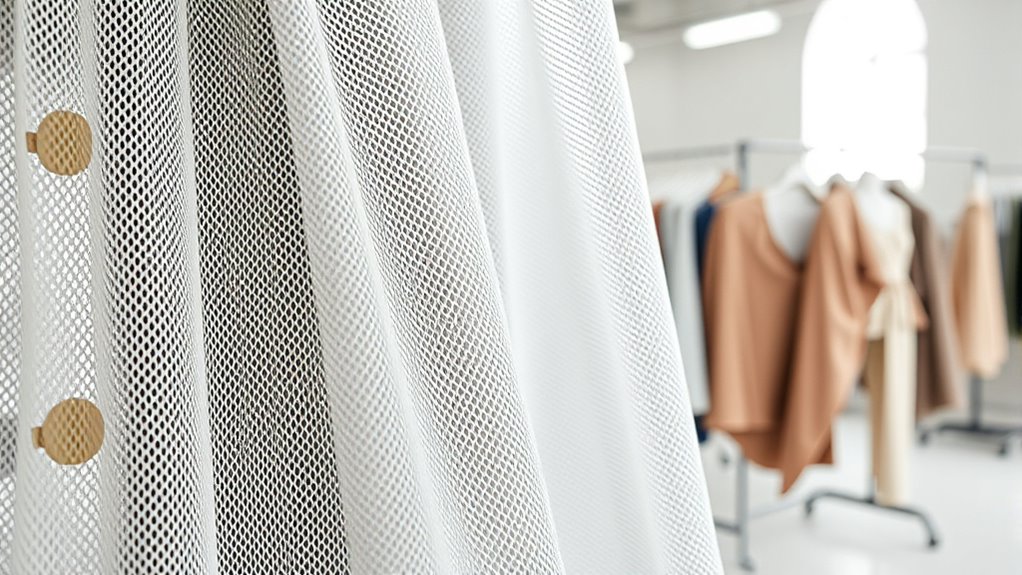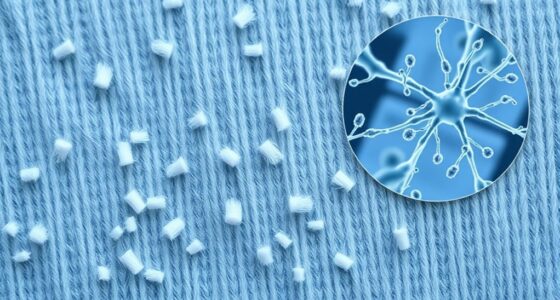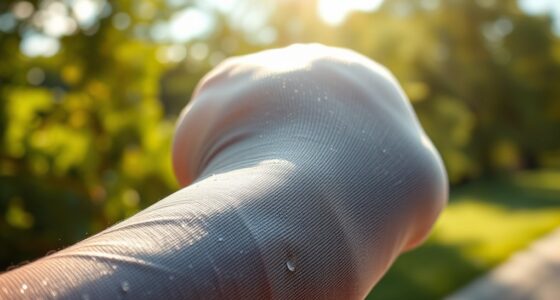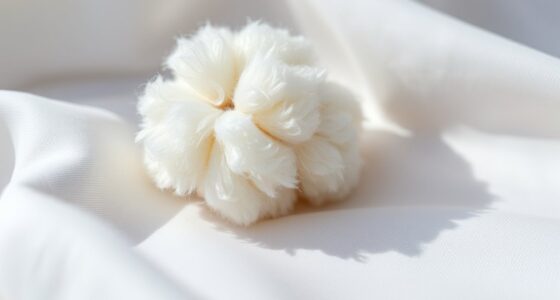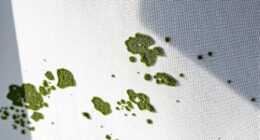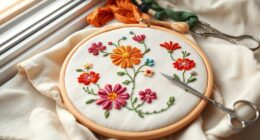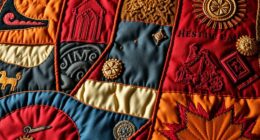Breathable fabrics keep you comfortable by allowing air and moisture to pass through, preventing overheating and sweat buildup during physical activity. They achieve this through their fiber type, weave, and moisture-wicking properties. Natural fibers like cotton and linen, or specially designed synthetics with mesh panels and microfibers, promote airflow and moisture evaporation. Choosing the right fabric helps maximize ventilation and keeps you cool. If you continue exploring, you’ll learn more about how each feature contributes to better clothing ventilation.
Key Takeaways
- Looser weave or knit structures allow more air to pass through, enhancing ventilation.
- Natural fibers like cotton, linen, and silk have high breathability due to fiber pores.
- Synthetic fibers with microfibers or mesh panels improve airflow and moisture evaporation.
- Moisture-wicking fabrics pull sweat away from the skin, aiding in faster drying and cooling.
- Fabric treatments and design features, such as mesh inserts, boost overall breathability and comfort.
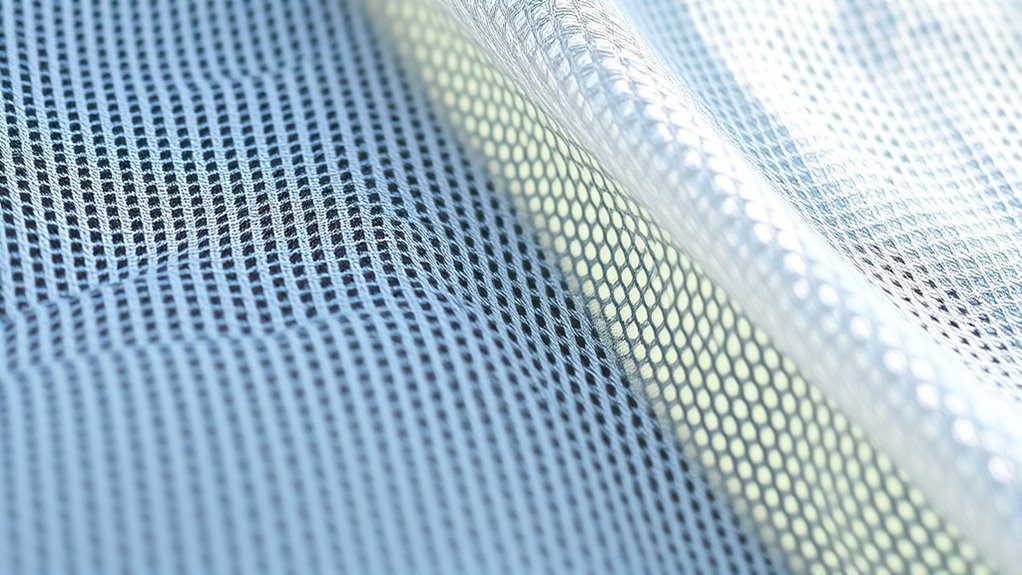
Have you ever wondered why some fabrics keep you cool and dry while others trap heat and moisture? The answer lies in how the fabric interacts with your body and the environment. Breathable fabrics are designed to promote ventilation, and understanding their key features can help you choose the right clothing for comfort and performance. One of the primary factors is moisture wicking properties. Fabrics with excellent moisture wicking capabilities pull sweat away from your skin and move it to the fabric’s outer surface, where it can evaporate more quickly. This process helps regulate your body temperature, preventing overheating and discomfort during physical activity or hot weather. When moisture moves efficiently, you stay dry longer, which reduces chafing and skin irritation, making breathable fabrics ideal for activewear and everyday use.
Fiber breathability is another *essential* element. It refers to how easily air can pass through the fabric, allowing heat and moisture to escape from your body. Fabrics made from natural fibers like cotton, linen, and silk typically have high breathability because their fibers have spaces and pores that facilitate airflow. On the other hand, many synthetic fibers like polyester or nylon are engineered to enhance moisture wicking, but their breathability can vary depending on their weave and treatment. Some synthetic fabrics incorporate mesh panels or are engineered with microfibers that maximize fiber breathability, offering a balance between moisture management and airflow. This combination ensures that heat and moisture don’t get trapped next to your skin, keeping you comfortable in a range of conditions.
The weave or knit of the fabric also plays a significant role. Looser weaves create more space between fibers, allowing better airflow and quicker moisture evaporation. Conversely, tighter weaves might trap more heat, which is less desirable in hot environments. When selecting breathable clothing, look for fabrics with a looser weave and known moisture wicking properties, especially if you’ll be engaging in physical activity or spending time outdoors.
Frequently Asked Questions
How Do Breathable Fabrics Perform in Extreme Weather Conditions?
In extreme weather, breathable fabrics help you stay comfortable by managing moisture and regulating temperature. They wick sweat away from your skin, preventing overheating or chill. During hot days, they keep you cool by promoting airflow, while in cold conditions, they insulate and trap warmth. You’ll find these fabrics perform well because they adapt to your body’s needs, ensuring you stay dry and thermally balanced no matter the weather.
Can Breathable Materials Be Environmentally Sustainable?
Yes, breathable materials can be environmentally sustainable. You’ll find eco-friendly dyes that reduce water and chemical use, making production less harmful. Recycled fibers, like recycled polyester or nylon, help lower waste and conserve resources. By choosing fabrics made with these sustainable practices, you support eco-conscious fashion, reducing your environmental impact while staying comfortable and well-ventilated. Sustainability and breathability can go hand-in-hand if you look for these eco-friendly options.
Are There Health Benefits Associated With Wearing Breathable Fabrics?
Wearing breathable fabrics offers health benefits like improved moisture management and enhanced skin comfort. These materials help wick sweat away from your skin, reducing irritation and the risk of fungal infections. By maintaining a dry and comfortable environment, you lower your chances of chafing and skin issues. Breathable fabrics support better temperature regulation, making you feel cooler and more comfortable during physical activities or hot weather.
How Do Different Weaves Affect Fabric Ventilation?
You might think all weaves let air flow freely, but the truth is, different weaves dramatically impact fabric ventilation. A loose weave with high fiber porosity allows more air to pass through, keeping you cool. Conversely, a tight weave with low fiber porosity traps heat and moisture. Weave density controls breathability—sparser weaves breathe better, while dense ones block airflow. So, choose your weave wisely for maximum ventilation!
Do Breathable Fabrics Require Special Maintenance or Washing Care?
Breathable fabrics do necessitate some special care to maintain their ventilation qualities. Check the washing instructions to avoid harsh detergents or high heat, which can damage fabric durability. Always wash in cold or lukewarm water and avoid bleach to preserve breathability. Proper maintenance ensures your clothing stays ventilated longer and retains its fabric integrity, so follow the care label closely for best results.
Conclusion
Remember, you get what you pay for. Choosing breathable fabrics guarantees your comfort and keeps you feeling fresh all day long. When selecting clothing, pay attention to the material’s ventilation properties; they make all the difference. Don’t settle for less, because investing in quality fabrics means better airflow and happier days. As the saying goes, “A well-breathed cloth keeps the body at ease.” Prioritize breathable fabrics for clothing that truly works with you.

